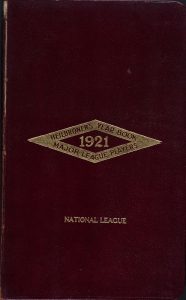By: Tony Hynes
One hundred years ago on the opening day of the 1921 baseball season, April 13, manager Johnny Evers’ Chicago Cubs were set to host Branch Rickey’s St Louis Cardinals for a 4-game series. This series was followed by 150 more scheduled games, ending with pennants for neither team (the Cardinals finished third and the Cubs seventh) and a World Series victory to the New York Giants over Babe Ruth’s New York Yankees on October 13 [1]. Then, as now, there was much to be done to make this happen, both behind the scenes in the front office, and from the perspective of managers and players. Information is key to pulling it all together, but where does it come from?
The Rare Book & Manuscript Library is fortunate to have two important published tools for any baseball organization of that time. Purchased from the reference collection of the former offices of the American League of Professional Baseball Clubs, each one tells a different side of the complex journey beginning on Opening Day, and of one man’s dedication to details.


Baseball Blue Book for 1921. Ft. Wayne, Ind.: Louis Heilbroner. Shelfmark: IUB1800
For the front office, the Baseball Blue Book was an essential source for information on all things related to the professional baseball leagues and the college game. Core elements were its directories. These laid out the administrative structure, the names and addresses for the various Major and Minor leagues and administrative staff, the umpires for that year, and even the members of the Baseball Writers’ Association of America. It presents the start and end dates for league seasons, and their full schedules in an easy-to-read tabular format. Also found are the agreements and rules that governed the professional game, and the changes introduced for the 1921 season.
One hundred years ago the most significant change to the Major League Agreement was the creation of the Office of the Commissioner, with Federal District Judge Kenesaw Mountain Landis selected by the owners to restore the integrity of an entire industry floundering in the wake of a gambling scandal unresolved since the 1919 World Series. This is the position of power in baseball in the last one hundred years (as many a player and owner, including eight banished White Sox players and, lately, Reds player Pete Rose, has found). An interesting element of the Agreement (Article 1, Section 6) states that that the President of the United States may be asked by either league to designate a commissioner should a successor not be selected within three months of the office being vacant.


Baseball Blue Book for 1921. Ft. Wayne, Ind.: Louis Heilbroner. Shelfmark: IUB1800


Heilbroner’s Year Book Major League Players: records and information of major league players 1921. Fort Wayne, Ind.: Heilbroner Baseball Bureau. Shelfmark: IUB1811a
For those most directly involved in the management of the game itself, the manager, scouts, and players, Heilbroner’s Year Book Major League Players for 1921 provided essential information on all (yes all) major league players who played the previous year in both leagues. In the “Publisher’s Preface” it lays claim to being “the most thoroughly up-to-the-minute baseball handbook ever devised.” Bound in a nice red cover, it is a directory of players for each of the eight teams in both major leagues with full names and addresses (though Babe Ruth is only listed with “Boston” as his address). More importantly, it is the source (nicely indexed) for the performance statistics for those who played ten or more games and/or pitched at least one game. One of its advertised strengths is that it is organized by player position, making it easy to compare players within those positions. Among the new compiled statistics to this 1921 edition: batting average (BA), runs batted in (RBI), fielding average (FA), games pitched (GP), complete games (CG), and shutout games (SG).

Heilbroner’s Year Book Major League Players: records and information of major league players 1921. Fort Wayne, Ind.: Heilbroner Baseball Bureau. Shelfmark: IUB1811a
Whether setting up the line-up card for the day, or preparing for an upcoming opponent, the data may prove a valuable early season guide to managers and their staff. It might even inform them on potential player acquisitions they might look to scout. Players with access to the volume may also see where they stand among their peer group (and provide some fun and games for those long trips between cities perhaps?).

Heilbroner’s Year Book Major League Players: records and information of major league players 1921. Fort Wayne, Ind.: Heilbroner Baseball Bureau. Shelfmark: IUB1811a
The compiler and publisher of both the Blue Book and the Year Book was Louis Heilbroner, the former manager of the 1900 St. Louis Cardinals (with a record of 23 wins and 25 loses). Heilbroner went on to set up the Heilbroner’s Baseball Bureau Service in 1913 in Ft. Wayne, Indiana, producing these and other baseball titles that were valued within the sport until his death in 1933 [2]. With the Bureau and its work, Heilbroner can be considered a key figure in the history of baseball management and in the evolution of modern sabermetrics.
Baseball Blue Book for 1921. Ft. Wayne, Ind.: Louis Heilbroner. Shelfmark: IUB1800
Heilbroner’s Year Book Major League Players: records and information of major league players 1921. Fort Wayne, Ind.: Heilbroner Baseball Bureau. Shelfmark: IUB1811a
Note: RBML is the only public institution to have a copy of this title. The Baseball Hall of Fame and Museum is the only other listed owner.
[1] Baseball Reference [Accessed March 31, 2021: https://www.baseball-reference.com/leagues/MLB/1921.shtml]
[2] Baseball Reference [Accessed March 31, 2021: https://www.baseball-reference.com/bullpen/Louie_Heilbroner]